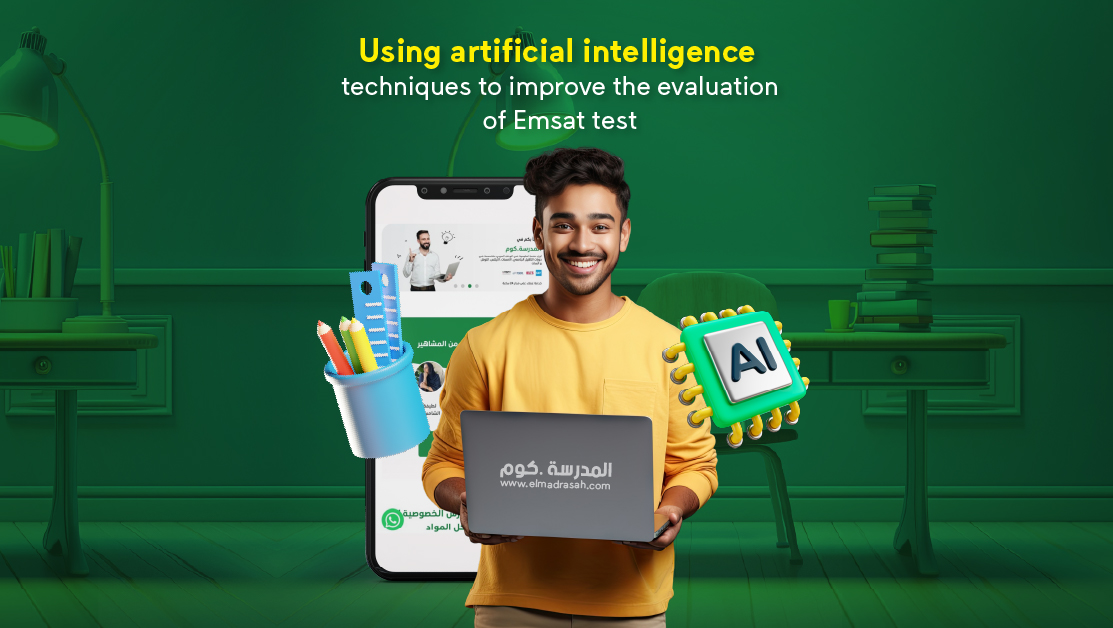
With the rapid evolution of technology and the widespread adoption of smart technologies, artificial intelligence (AI) has become crucial in various aspects of life, including education. The UAE’s EmSAT test is witnessing increasing use as a pivotal tool to assess the academic and linguistic skills of students applying to universities and higher institutes.
This article aims to explore the role of AI technologies in the evaluation of Emsat test and how these technologies can contribute to improving students’ experiences and assessment accuracy. By harnessing AI capabilities, significant progress can be made in analyzing test results, developing new assessment methods, providing personalized guidance to students, and enhancing objectivity and fairness in the evaluation process.
Future research in the evolution of Emsat test: The role of AI tools in education, improving design, and skill measurement
Test development is crucial in education and evaluation, especially in improving EmSAT assessments by enhancing test design and providing effective measurement tools for academic and linguistic skills to achieve more accurate and fair evaluations. Thanks to advancements in AI, it can be used to enhance test development processes in the future.
AI can contribute to developing new, more efficient methods for measuring academic skills with greater accuracy. Traditional assessments rely on paper-based or computerized tests, but AI can provide innovative assessment solutions. For example, machine learning techniques and big data analysis can be used to estimate performance, analyze patterns, and identify individual trends for each student. This can lead to a more comprehensive and objective assessment of students’ skills.
Furthermore, AI can enhance language test development more effectively. Language is fundamental for communication and learning, and language tests play a critical role in evaluating students’ skills. Techniques such as natural language processing and machine learning can be used to improve language test design and analyze students’ performance. AI can identify common errors and language biases, guiding test question design to promote proper understanding and fair evaluation.
Additionally, AI can contribute to developing interactive tests. Interactive testing adapts questions based on students’ performance during the test. AI can analyze students’ performance instantly and provide adaptive questions according to each student’s level. This means the test can be more challenging for advanced students and less challenging for those with lower proficiency, ensuring a personalized and fair assessment experience for all.
However, it’s important to consider challenges and considerations associated with using AI in test development. For instance, ensuring that the models and data used in training and evaluation are balanced and represent diverse student populations. Privacy and security issues in collecting and analyzing students’ personal data must also be taken into account.
In conclusion, artificial intelligence represents enormous potential for improving test design and measuring academic and linguistic skills more effectively. By leveraging machine learning and data analysis techniques, assessment accuracy and fairness can be enhanced. With continued focus on research and innovation, significant advancements in test development can be expected in the future, enhancing the quality of education and student performance evaluation.
Big Data Analysis for Improving Questions and Topics: Identifying Trends and Common Patterns in Questions and Topics
In our current era, significant attention is being given to the analysis of big data to extract benefits and leverage them across various fields. Educational institutions are one of these areas that can greatly benefit from big data analysis to enhance questions and topics.
The evaluation of EmSAT test is one of the tools used to assess students and measure the knowledge and skills necessary for success in higher education. With a vast amount of data available related to the results of these tests, artificial intelligence (AI) techniques and big data analysis can be applied to extract patterns and trends related to questions and topics.
Through big data analysis, the most challenging or frequently occurring questions, which pose difficulties for students, can be identified. This information can be used to improve the question preparation process and develop teaching strategies and curricula. By modifying and enhancing questions based on data and analysis, the effectiveness and accuracy of assessments can be enhanced in evaluating students’ knowledge and skills.
In addition to analyzing questions, big data analysis can be used to identify common patterns in topics that require improvement or modification. Analyzing student responses and patterns in test assignments can identify topics that students struggle with the most and need enhancement and development.
For example, if there is a consistent pattern of incorrect answers in a specific topic, it may indicate weaknesses in teaching that topic or formulating related questions. Through big data analysis, educational institutions can identify these common patterns and take actions to improve teaching these topics or modify questions to achieve better understanding and higher student performance.
Artificial intelligence technology plays a crucial role in big data analysis and extracting patterns and trends from it. Techniques such as machine learning, text analysis, classification, and clustering can contribute to understanding data and uncovering relationships and trends that may not be clearly evident to humans. Through these techniques, educational institutions can leverage the power of artificial intelligence to analyze big data and improve questions and topics.
In conclusion, big data analysis represents a significant opportunity for educational institutions to enhance assessment processes, develop questions and topics, and the evaluation of Emsat test itself. By using modern techniques in artificial intelligence, analyzing big data can provide valuable insights to improve education quality and enhance students’ experiences in educational institutions.
Developing Machine Learning Models for Self-Assessment: Enhancing Self-Assessment Models for Students to Identify Strengths and Weaknesses More Accurately
The evaluation of the EmSAT test is an assessment used to determine the level of knowledge and skills required for success in higher education. Typically, students are assessed by a team of teachers and evaluators, but leveraging machine learning techniques can help develop self-assessment models that students can use to independently analyze their performance and improve EmSAT test results.
Machine learning techniques rely on computers’ ability to learn patterns and acquire knowledge from data. These techniques can be applied to historical data from previous EmSAT test results to build machine learning models capable of analyzing students’ performance and providing accurate self-assessment.
When using machine learning techniques, models are trained using historical data of student performance on EmSAT exams. This data is analyzed to discover patterns and relationships between students’ performance, exam questions, and assessment criteria used.
Through analyzing this data, machine learning models can identify students’ strengths and weaknesses more accurately than traditional assessment methods. Models can analyze students’ performance across a variety of questions and extract information about concepts students excel in and those they need to work on improving.
Additionally, machine learning techniques can contribute to providing specific and effective feedback to students based on performance analysis. Models can analyze common errors made by students and provide suitable guidance for improvement.
By utilizing machine learning models for self-assessment, students can benefit from the advantages of accurate self-analysis of their performance on EmSAT exams. They can identify their strengths and weaknesses more precisely and work on improving the necessary skills for success in higher education.
Furthermore, machine learning models can be used to personalize education according to each student’s needs. When students’ performance is analyzed accurately, models can identify topics and concepts that students need to focus more on and provide appropriate assistance.
It is also important to note that using machine learning models for self-assessment requires sufficient and reliable training data. Models should be capable of learning from a large and diverse set of previous data to achieve high accuracy in assessment.
In conclusion, machine learning techniques can be used to develop self-assessment models for students in EmSAT exams. This allows students to analyze their performance, identify strengths and weaknesses more accurately, and work on improving the necessary skills for success in higher education. Using machine learning in this context can contribute to improving the assessment process and enhancing the learning experience for students.
Providing Personalized Guidance and Improving Test Readiness: Offering Customized Guidance to Students on Areas Requiring Focus
The EmSAT test is an assessment used to measure the level of knowledge and skills needed for success in higher education. To achieve good performance on the test, students require thorough preparation and focus on the required concepts and skills.
By utilizing data analysis and artificial intelligence, previous data on students’ performance in past EmSAT tests can be collected and analyzed. This data is analyzed to discover patterns and relationships between students’ performance, test content, and important concepts.
When data is analyzed correctly, machine learning models can provide personalized guidance to each student based on their strengths and weaknesses in various subjects covered in the EmSAT test. Student performance is analyzed on an individual level to identify concepts that require more focus and improvement.
Through providing personalized guidance, students can identify areas of weakness in their knowledge and work on strengthening them. Machine learning models can identify specific skills that students need to improve and provide suitable guidance to achieve that.
Moreover, data analysis and artificial intelligence can be used to provide customized educational resources for each student. Based on the analysis of student performance and identifying important concepts, additional and appropriate educational materials can be provided to meet each student’s individual needs.
Using data analysis and artificial intelligence techniques, continuous assessment of student progress can also be conducted, updating guidance accordingly. This allows for monitoring development and providing updated guidance to help improve performance over time leading up to the test.
It is evident that utilizing data analysis and artificial intelligence provides significant opportunities to enhance students’ readiness for the EmSAT test and increase their chances of success in this important examination. Personalized guidance and customized educational resources enhance students’ understanding and confidence in the required subjects and skills, contributing to achieving better results in the test.
Continuous Assessment and Continuous Improvement: Conducting ongoing assessment of EmSAT test performance and providing accurate reports indicating students’ progress
Continuous testing and assessment are powerful tools for evaluating student performance, identifying strengths and weaknesses, and directing efforts towards continuous improvement. With the use of advanced technology like artificial intelligence, these processes can be enhanced and improved for the benefit of both students and teachers.
By utilizing artificial intelligence, data on students’ performance in the EmSAT test is collected and analyzed with utmost precision. These analyses enable educators and educational administrators to gain deeper insights into student performance, assess their progress levels, and identify areas for potential improvement.
One of the key advantages of using artificial intelligence in continuous assessment is the ability to provide accurate and detailed reports. Machine learning models can comprehensively analyze data and provide reports that illustrate students’ performance on an individual and collective level. This means that educators and educational administrators can gain a comprehensive view of overall performance levels and identify general patterns and trends.
These detailed reports provide strong indicators regarding the skills and concepts students possess and those that need improvement. Educators can use this information to develop educational strategies targeting specific subjects and concepts, enhancing students’ understanding and the evaluation of the EmSAT test.
Moreover, artificial intelligence can be used to analyze historical data and track students’ progress over time. Educators and educational administrators can monitor student progress, identify areas in need of continuous improvement, and provide guidance and assistance to help students overcome challenges and achieve continuous progress.
Furthermore, artificial intelligence can be utilized to develop customized and individualized educational tools. Smart technologies can respond to individual students’ needs and provide adaptive and suitable education. By analyzing previous performance and students’ personal data, artificial intelligence can guide educational materials and provide suitable recommendations to enhance students’ learning and achieve better performance in the EmSAT test.
However, we must address some challenges and considerations related to using artificial intelligence in continuous assessment. One of the most important challenges is data protection and ensuring privacy. It must be ensured that data collection and analysis are done securely and responsibly to protect students’ and teachers’ privacy.
Additionally, attention must be paid to ensuring a proper balance between technical and human aspects in the continuous assessment process. Artificial intelligence is a powerful tool for data analysis and providing recommendations, but educators and educational administrators must play an active role in interpreting the data and making appropriate decisions to improve teaching and learning.
In conclusion, the use of artificial intelligence in continuous assessment and continuous improvement represents a significant development in the field of education. This usage provides the ability to analyze data accurately and provide detailed reports that contribute to improving students’ performance and directing efforts towards areas in need of improvement. With continued focus on ethics and privacy, artificial intelligence can be a strong partner in enhancing education quality and achieving students’ academic success.















